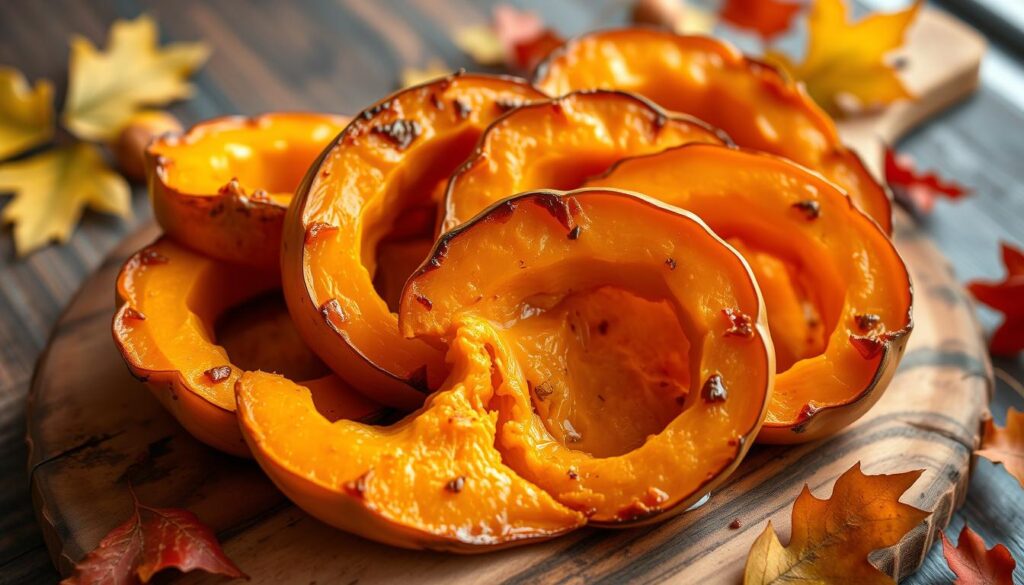As autumn’s cool air arrives, the smell of roasted kabocha squash soup fills the kitchen. It brings back memories of warm family times. This creamy, nutritious dish is a treat for the senses. With a few easy tips, you can make this autumn delight at home.
Kabocha squash, or Japanese pumpkin, is a fall treasure. Its bright orange flesh and sweet taste are perfect for a nourishing soup. Roasting the squash with garlic adds a rich flavor that will delight your taste buds.
Key Takeaways
- Kabocha squash soup is a velvety, rich, and delicious autumn dish.
- Roasting the squash with garlic enhances the flavor.
- This nutritious soup is easy to make, comforting on chilly days, and perfect for meal prep.
- Kabocha squash, also known as Japanese pumpkin, is sweeter than butternut squash and available in grocery stores or Asian supermarkets.
- The recipe includes olive oil, kabocha squash, carrots, onion, garlic, vegetable broth, heavy cream, fresh herbs, and apple cider vinegar.
Understanding Kabocha Squash: The Japanese Pumpkin
Kabocha squash, also known as Japanese pumpkin, has a dark green or red-orange skin. Its vibrant orange flesh is sweet and creamy. It’s even sweeter than butternut squash. This squash is a key ingredient in kabocha squash soup japanese and kabocha squash soup just one cookbook recipes.
Nutritional Benefits and Flavor Profile
Kabocha squash is full of nutrients like beta-carotene and vitamins C, B1, and B2. It’s low in calories but rich in fiber. Its flavor is sweet, creamy, and nutty, with a perfect balance of savory and sweet.
Selecting and Storing Your Squash
Choose a heavy, well-shaped squash without soft spots or blemishes. The skin should be dark green or red-orange and matte. Store it in a cool, dry place for up to 3 months. Cut squash can be refrigerated for up to 3 days or frozen for up to 3 weeks.
Seasonal Availability
Kabocha squash is available from late summer to early winter. But, you can find it year-round in Asian markets and specialty stores. The sweetest squash is harvested in fall and early winter.

“Kabocha squash is a beloved Japanese winter squash known for its exceptional sweetness, being a hybrid of sweet potato and butternut squash.”
Essential Ingredients for Perfect Kabocha Squash Soup
Making a delicious kabocha squash soup starts with picking the right ingredients. The main ingredient is the kabocha squash. A large squash, about 4 pounds, is perfect for a rich and creamy soup. Roasting it at 425 degrees Fahrenheit for 30-35 minutes enhances its sweetness and flavor.
Onion, garlic, and fresh ginger add a deep aroma. For the right texture, use 3 cups of low-sodium vegetable broth and 13.5-ounce coconut milk. Spices like cumin and turmeric add warmth, while lime juice brightens the taste.
For a vegan version, use full-fat coconut milk instead of heavy cream. Roast the squash and sauté the aromatics with olive oil or another neutral oil. Fresh herbs like cilantro or sage add a final burst of flavor.
| Ingredient | Amount |
|---|---|
| Kabocha Squash | 1 large (approx. 4 lbs) |
| Onion | 1 medium, diced |
| Garlic | 3 cloves, minced |
| Ginger | 1 tbsp, grated |
| Vegetable Broth | 3 cups, low-sodium |
| Coconut Milk | 1 can (13.5 oz), full-fat |
| Cumin | 1 tsp |
| Turmeric | 1/2 tsp |
| Lime Juice | 2 tbsp |
| Olive Oil | 2 tbsp |
| Fresh Herbs (Cilantro or Sage) | 1/4 cup, chopped |
With these ingredients, you’re ready to make a cozy and tasty kabocha soup for autumn.

Roasting Techniques for Enhanced Flavor
Boost the flavor of your roasted kabocha squash soup by learning to roast. It’s all about finding the right temperature and timing. This brings out the squash’s sweetness and adds depth to your soup.
Temperature and Timing Guidelines
Heat your oven to 425°F (218°C). Roast the kabocha squash for 30-35 minutes. This makes it tender, lightly browned, and caramelized. It greatly improves your soup’s taste.
Seasoning and Oil Selection
Before roasting, toss the squash with olive oil, salt, and pepper. The oil gives it a great aroma and flavor. The seasoning enhances the squash’s natural sweetness.
Tips for Easy Cutting and Preparation
- To make cutting easier, microwave the whole kabocha for 1-2 minutes first.
- Use a sharp knife and sawing motion to cut the squash. Make sure to remove the seeds before roasting.
Roasting the kabocha squash unlocks its full flavor. It makes your roasted kabocha squash soup even better.

Creamy Base Options: Beyond Coconut Milk
Creating the perfect kabocha squash soup depends on the creamy base. Full-fat coconut milk is a favorite, but there are other great choices too. These options can change the soup’s texture and taste.
Cashew milk adds a creamy, rich feel to your vegan kabocha squash soup. On the other hand, light coconut milk gives a lighter soup. It’s perfect for those who prefer a less thick soup.
For those who can have dairy, heavy cream or half-and-half are great. They make the soup creamy. Your choice depends on your diet and taste preferences.
Try different creamy bases to match the kabocha squash‘s natural taste and texture. You can make a delicious and satisfying kabocha squash soup in many ways.

Kabocha Squash Soup: Classic Recipe Steps
Make a delicious kabocha squash soup with this classic recipe. Kabocha squash, also known as the Japanese pumpkin, has a sweet, nutty flavor and creamy texture. Follow these simple steps to make a warm, autumnal soup that will please your taste buds.
Preparation Method
Start by roasting the kabocha squash. Preheat your oven to 400°F (200°C) and line a baking sheet with parchment paper. Cut the squash in half, remove the seeds, and place the halves cut-side down on the baking sheet. Roast for 45-60 minutes, until the flesh is tender.
While the squash roasts, sauté the aromatics. In a large pot or Dutch oven, heat 2 tablespoons of coconut oil over medium heat. Add diced onions, minced garlic, and grated ginger. Cook, stirring occasionally, until the onions are translucent and the garlic is fragrant, about 5-7 minutes.
Cooking Timeline
Once the squash is roasted, scoop out the flesh and add it to the pot with the sautéed aromatics. Pour in 4 cups of vegetable broth and a 13.5-ounce can of reduced-fat coconut milk. Bring the mixture to a simmer and cook for 12-15 minutes, allowing the flavors to meld.
Blending Techniques
After simmering, use an immersion blender to puree the mixture until smooth and creamy. Or, you can blend the soup in batches in a high-powered blender. For a smoother texture, strain the blended soup through a fine-mesh sieve.
Finally, stir in 2 tablespoons of fresh lime juice and adjust the seasoning with salt and black pepper to taste. Serve the kabocha squash soup warm, garnished with your favorite toppings, such as roasted pumpkin seeds, chopped cilantro, or a drizzle of coconut milk.
Asian-Inspired Variations and Spice Combinations
Add a touch of Asian flair to your kabocha squash soup. For a Thai twist, mix in a tablespoon of red curry paste. Add lemongrass or lime zest for a fragrant touch. For Vietnamese flavors, try fish sauce and a hint of star anise.
For an Indian-inspired soup, blend warm spices like ginger, turmeric, and coriander. Adjust the coconut milk to balance the spices. This creates a creamy and aromatic soup.
- Thai-inspired: Red curry paste, lemongrass, lime zest
- Vietnamese-style: Fish sauce, star anise
- Indian-influenced: Ginger, turmeric, coriander
These variations bring exciting flavors to your kabocha squash soup. They keep the creamy texture of the kabocha squash base. Be adventurous and find your favorite Asian-inspired kabocha squash soup!
Garnishing and Serving Suggestions
Adding the right garnishes and serving choices can make the chunky kabocha squash soup even better. Start by pouring the smooth soup into bowls. Then, try these tasty toppings to add texture and flavor:
- Toasted pumpkin seeds or sunflower seeds for a satisfying crunch
- Freshly chopped cilantro or parsley to add a bright, herbaceous note
- A drizzle of creamy coconut milk or yogurt to balance the richness
Texture Enhancers
For a more indulgent experience, add some texture-boosting elements. Roasted chickpeas or crispy fried shallots can add a delightful contrast to the smooth soup.
Complementary Side Dishes
The soup goes well with crusty bread, like a warm baguette or vegan naan. It’s perfect for dipping and sopping up every last drop. Serve it with a fresh salad, like a Thai-inspired cabbage slaw or quinoa salad, for a complete meal.
To make the soup chunkier, save some roasted kabocha squash cubes. Fold them in after blending the rest of the ingredients. This adds a delightful textural contrast and highlights the natural sweetness of the Japanese pumpkin.
Storage Solutions and Reheating Tips
Enjoying the creamy, autumn-inspired kabocha squash soup doesn’t have to end. You can keep enjoying it for days with the right storage and reheating. This way, you can relish the comforting flavors of this dish for longer.
To store leftover kabocha squash soup, put it in airtight containers. Then, refrigerate it for up to 5 days. If you want to keep it longer, freeze it for up to 2 months. Freezing in smaller portions makes reheating simpler.
When reheating your kabocha squash soup, start by warming it on the stovetop. Use low to medium heat and stir often until it’s hot. You can also microwave it for 1-2 minutes, stirring halfway. If it’s too thick, add a bit of broth or water to thin it out.
These simple steps make it easy to enjoy kabocha squash soup again and again. It’s perfect for busy weeknights or cozy gatherings in autumn.
Dietary Modifications and Substitutions
Making a vegan version of kabocha squash soup is easy. Just replace dairy with plant-based options. Use coconut milk or cashew milk instead of regular milk or cream. For a fat-free version, cook veggies in water or vegetable broth.
Change the spices to your liking. Add more for a stronger taste or less for a milder soup. For less fat, choose light coconut milk or more broth.
Can’t find kabocha squash? No worries! Use butternut squash or pumpkin for a similar taste. And for gluten-free diets, pick gluten-free ingredients.
| Ingredient | Vegan Substitute | Gluten-Free Substitute |
|---|---|---|
| Dairy Milk or Cream | Coconut Milk, Cashew Milk | Dairy-Free and Gluten-Free Alternatives |
| Butter or Oil | Vegetable Broth, Water | Gluten-Free Oil or Broth |
| Kabocha Squash | Butternut Squash, Pumpkin | Gluten-Free Squash Varieties |
| Broth | Vegetable Broth | Gluten-Free Vegetable Broth |
With a few simple changes, you can make a vegan kabocha squash soup for any diet. Be creative and enjoy the cozy taste of autumn in a bowl.
Conclusion
Kabocha squash soup is a delicious and nutritious dish for autumn. Its creamy texture and sweet taste make it a favorite. You can try classic or Asian-inspired recipes for a cozy meal.
It’s a great choice compared to butternut or acorn squash soups. Kabocha squash soup has a unique flavor and is packed with nutrients. Its vibrant color and robust taste make it a must-try in fall and winter.
This guide has shown you how to make perfect kabocha squash soup. You can experiment with spices and garnishes to make it your own. Let your creativity shine in every spoonful.

